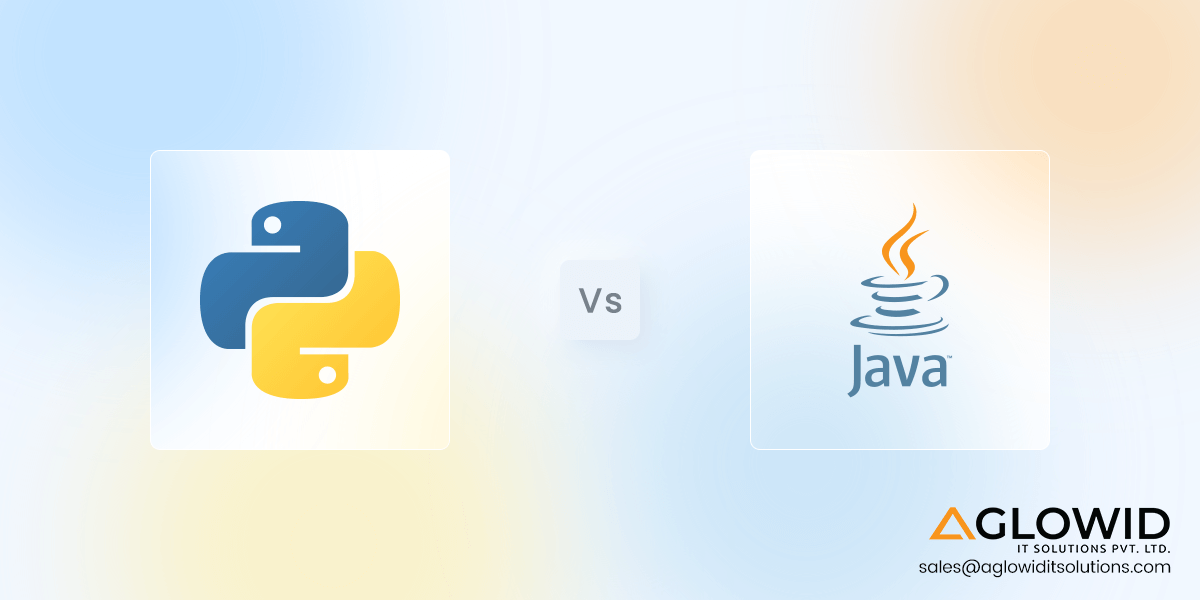Quick Summary:
Need to decide between Python and Java for your next project? Several key factors influence the decision of which programming language is better suited for your business needs. Here is a detailed comparison of Python vs Java to help you make an informed decision.
The debate of Python vs Java is a heated topic amongst the developers’ community. Though it is an important and obvious comparison, most people often do not realize that Python and Java are both competent and capable programming languages that excel in different applications and fields.
They are two of the most popular programming languages used globally by many skilled developers and enterprises for various projects and software requirements. Both Java and Python are exceptionally known for their unparalleled cross-platform support and extensive libraries.
Java vs. Python Overall Market Scenario
- Python vs Java Popularity over the years
- Java vs Python Developer Salary Comparison
- Java vs Python Community Support
1. Python vs Java Popularity over the years

Until December 2019, Python and Java were neck to neck in terms of search volume or interest over time as per Google Trends. Around 16th Feb 2020, Python compared to Java, took a considerable lead and maintained its popularity lead ever since.

This is again proved through StackOverflow Trends, where we can see the sudden rise in Python questions over the years compared to declining questions about Java after 2016.
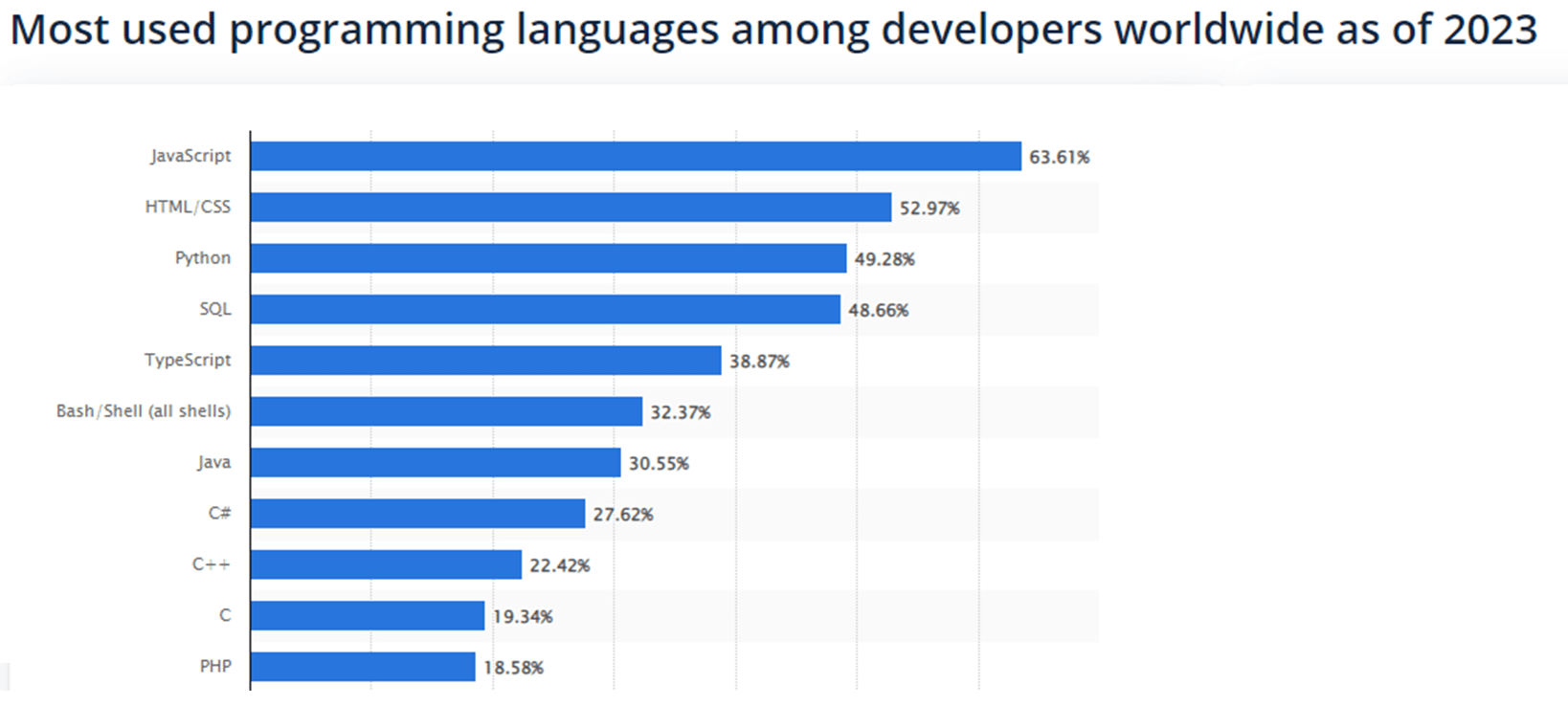
As per a study conducted by Statista, Python has ranked the third most used programming language among developers worldwide, and Java ranks seventh.
Various reports, surveys, and trends indicate that Python is gaining more popularity than Java; however, this does not indicate that Java is becoming obsolete or irrelevant. Java has many benefits and is still a preferred programming language for enterprise-grade and custom software projects due to its faster runtime and easy debugging abilities.
2. Python vs Java Developer Salary Comparison
Instead of comparing the current median salaries of Python and Java only for the year 2025, we thought its better to compare the average median salary raise of Java vs Python developers from 2022 to 2023. Here are the stats as per Stack Overflow Survey 2023 –
Java Salary Growth

As per the 2023 Stack Overflow Survey, Java developers were earning $64,572/year in 2022 which increased to $72,701/year just a year later in 2023.
Python Salary Growth

Whereas Python started stronger than Java by providing median salary of $71,105 in 2022 which raised to $78,331 this year.
However, if you notice, the growth in terms of percentage is way higher in Java compared to Python salaries.
3. Python vs Java Community Support
For any programming language, it is important to have community support. When you have an active community of developers, they can build tools and allow other users to utilize them for their projects. Similarly, you can utilize tools created by other developers as well.
Both Python and Java enjoy strong and active community support globally. Python has famous channels like PySlackers, PyCon convention, FreeNode IRC Python and PyLadies have contributed majorly to Python’s popularity and diversity of programmers. Python Community is also very active and helpful.
Java is Oracle’s product, and conventions like JavaWorld, Oracle Code One, and JavaRanch are important players in spreading the popularity of Java in software development. Many other Java User Groups (JUGs) are spread across the globe.
How to choose the right programming language for your project?
Before we start with the comparison of ‘Python vs. Java’, it is important to have a basic understanding of the factors you need to look for when deciding the right programming language for your custom project. This will help give you better clarity in defining your purpose, which will then be instrumental in selecting the right programming language between Python and Java.
Programming Language Selection Checklist
- Development Speed.
- Execution Speed.
- Robustness of the Programming Language.
- Developer Availability.
- Execution Environment.
- Ecosystem and Community.
- Connection with other Programming Languages and Ecosystems.
Overview on Java and Python
Before we get into the details of the differences between Java and Python, it is important to have some fundamentals clear to understand these programming languages at their core.
What is Java?
Java is a class-based, object-oriented programming language that is statically typed. Since it is statically typed and compiled, Java performs faster at runtime and is easier to debug than Python. Java was designed to have limited or least implementation dependencies. Java is also a general-purpose language most often used for mobile computing, games, numerical computing, desktop computing and websites.
Looking to Hire Dedicated JAVA Developers?
Trust offshore Java developers from Aglowid to develop robust web and mobile apps that can accelerate your growth.
Java Use Cases

- Desktop GUI Applications
- Mobile Applications
- Custom Enterprise Applications
- Web-based Applications
- Scientific Applications
- Embedded Systems
- Distributed Applications
- Big Data Technologies
Popular Applications based on Java

- Google and AndroidOS
- Netflix
- Spotify
- Uber
- Minecraft
- Amazon
What is Python?
Python is an interpreted, general-purpose programming language that is dynamically typed. The core philosophy behind Python was to make code easier to read and understand compared to other programming languages. The most common use cases for Python can be seen in data analytics and machine learning, though it is also used for many industries and purposes.
Python Use Cases
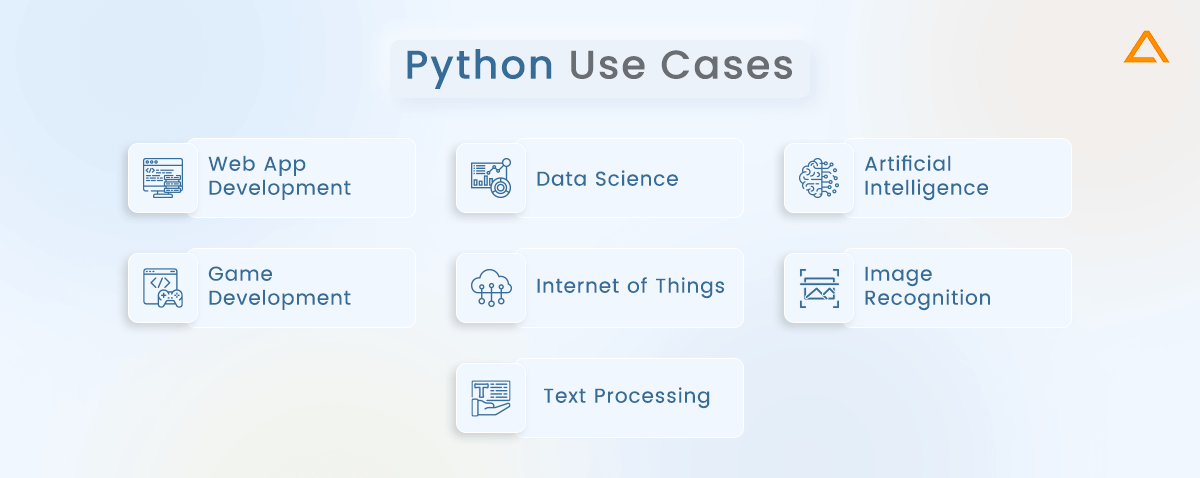
- Web Application Development
- Data Science
- Artificial Intelligence
- Game Development
- IoT – Internet of Things
- Image Recognition and Text Processing
Popular Applications based on Python

- YouTube
- Dropbox
- Quora
Java vs. Python Differences – Technical Comparison

- Python vs Java Performance
- Python vs Java Difficulty – Learning Curve and Code Readability
- Differences in Python Class vs Java Class
- Python vs. Java Differences in Typing
- Python vs Java Differences in Brevity
- Python vs. Java Terminators Differences
- Python vs Java Stability
- Python vs Java Portability
- Python vs Java Architecture
- Python Interpreter vs Java Compiler
- Python vs Java Memory Management
| Metrics | Python | Java |
| Performance | Dynamic, Slower | Static, Faster |
| Learning Curve and Code Readability | Python is easier to learn and read | Java is difficult to learn and read |
| Classes | Refers to a variable directly | Utilizes Getter and Setter Functions |
| Typing | Dynamic, Strongly Typed | Static, Strongly Typed |
| Brevity | More concise | More verbose |
| Terminators | Whitespace | ; , (), {} |
| Stability | Tested at runtime, less stable | Tested before running, more stable |
| Portability | High Portability | Higher Portability with use of JVM |
| Architecture | Uses PVM | Uses JVM |
| Translators | Python Interpreter | Java Compiler |
| Memory Management | Automatic and Manual Support – both | Automatic |
As we saw, there are many similarities and differences between Python and Java. This can make choosing one over the other difficult, as they more or less have similar capabilities and uses. However, if we dive deeper, you will understand the distinct features and key differences between Python and Java to help understand their potential, capabilities and limitations.
1. Python vs Java Performance
Python is a dynamically typed programming language that makes compilation difficult. Determining the variable type during runtime increases the workload of the interpreter. skilled Python developers boost their code execution through various implementations of the programming language. Some of the popular compilation Python tools include – Jython and Cython.
- Jython – compile Python code to Java Bytecode.
- Cython – compile Python code to C and C++.
These tools can also be used for optimizing the execution speed of Python applications.
In contrast, Java is a statically typed programming language that uses JVM – Java Virtual Machine to speed up the code execution through JIT (Just in Time). This helps convert the byte code to machine code more efficiently and quickly. Since the code is not interpreted, compiling doesn’t require memory usage and processor time.
Also Read – Python Best Practices to Follow in 2025
When to use Java?
Development of heavy applications.
When to use Python?
Small to midscale application development.
2. Python vs Java Difficulty – Learning Curve and Code Readability
Python is preferred over Java (especially by novice developers) because it is easier to read and execute Python code than Java. To understand this better, we should look at the Java and Python differences in syntax for adding two numbers.
Python Syntax
first = 5
second = 9
sum = first + second
print(sum)
Java Syntax
class AddNums
()
{
public static void main(String args[])
{
int first = 5;
int second = 9;
int sum = first + second;
System.out.println(sum);
}
}Which one looks easier and straightforward? Naturally, Python is more concise and easier to comprehend for developers of any experience level. Python is a dynamically typed programming language. Hence, there is no need to declare variables in contrast to Java, a statically typed programming language, due to which the developer needs to declare the variables explicitly.
Are you looking to hire Python developer?
Hire a dedicated team from Aglowid for high-quality python developers who are equipped with the latest Python skill-sets
3. Differences in Python Class vs Java Class
Python code generally runs top to bottom unless you tell it where you want it to start. Moreover, you can also take classes in Python, just like you can do with Java. The approach to making classes differ significantly in Python and Java.
Python Classes
class Number:
def __init__(self, left, right):
self.left = left
self.right = right
number = Number(4, 1)
print("4+1=", number.left + number.right)Here, the class we have defined is ‘Number .’ It has two variables – left and right. The default constructor used is _init_. We represent the object by calling the constructor number = Number (4,1). Now we can refer to the variables in the class as number.left and number.right.
This practice of referring to variables directly is discouraged in Java. Java developers use getter and setter functions to execute the same classes. This makes the code wordy and overly complex. Here is how Java classes with getter and setter functions look like –
Java Classes
class PrintNumber {
int left;
int right;
PrintNumber(int left, int right) {
this.left = left;
this.right = right;
}
public int getleft() {
return left;
}
public int getRight() {
return right;
}
}
public class Print5 {
public static void main(String[] args) {
PrintNumber printNumber = new PrintNumber (4,1);
String sum = Integer.toString(printNumber.getleft()
+ printNumber.getRight() );
System.out.println("4+1=" + sum);
}
}4. Python vs Java Differences in Typing
Both Python and Java are object-oriented programming languages, but Python uses dynamic typing, and Java uses static typing. This might sound like a minor difference, but it greatly affects how you write, design and fundamentally troubleshoot programs.
Java Typing Input
public class Main
{
public state void main(String[] args) {
int a=30, b=70;
int result = a+b;
System.out.printIn(“The result a+b= “+result); }
}Python Typing Input
a=30
b=70
print (‘The result a+b = ‘,a+b)Final Output
The result a+b = 1005. Python vs Java Differences in Brevity
As we have noted so far already, Java as a programming language is verbose. It forces the developers to think in a certain manner and write a lot more code to perform a task compared to other programming languages such as Python. Since Python is dynamically typed, it is less verbose than static languages such as Java, and this is because dynamic typing doesn’t need developers to declare new variables.
Python
var1 = “Hello World!”
var1 = 4 // simple type conversion, no new variable creationIn Python, you can create a variable named ‘var1’ and define a string value for that variable – Hello World! Once you close the string for that particular value, you can reuse the ‘var1’ variable for defining different data types, in our example, an integer ‘4’. This eliminates the need to create new variables for every new instance, reducing memory wastage.
Java
String var1 = “Hello World!
var1 = 4; // not allowed, var1 is a string
int var2 = 4; // create a new variable for storing integer valueIn Java, you cannot reuse ‘var1’ for two different data types. Java doesn’t allow this practice, due to which Java developers need to define a new variable ‘var2’ for defining the new integer value as 4. This leads to unnecessary use of extra memory.
6. Python vs Java Terminators Differences
Python is one of the few languages that doesn’t use semicolons (;) as a terminator but as a separation when writing multiple statements on the same line. Due to this, you can also add a semicolon at the end of a single statement. Python uses ‘Whitespace’ in place of semicolons as terminators, which means you don’t need to add any particular character at the end of your statement for moving to the next one. As opposed to this, Java follows standard programming language practices of using semicolons as terminators.
Now Python vs Java in terms of terminators is a very subjective topic, as to which one is better than the other is. Some developers believe Python is more concise, and uniform than Java as the formatting choices are limited, in contrast to Java that uses semicolons, parentheses and curly braces as terminators.
However, from a practical point of view, a seasoned developer that has experience coding in different programming languages might feel odd about the change in terminator formatting, making it difficult for them to adapt Python’s whitespace, and they might feel familiar and comfortable with Java’s semicolons, parentheses and curly braces. As opposed to this, new novice developers might use Python easier, as whitespaces are more natural as terminators rather than remembering to use semicolons after each statement.
7. Python vs Java Stability
One of the most important things to consider when deciding Python or Java for your long-term project is the programming language’s stability. If you intend to scale and use your program for years or decades, you need to know that the base you are building it on is stable and reliable enough.
When we compare Java to Python, Java comes out to be more stable as a programming language. This is because Python’s syntax is tested at runtime instead of Java, which requires all code to be reviewed and in working condition before running. Hence, Java is generally better tested and less prone to issues like code crashes compared to Python.
8. Python vs Java Portability
Another aspect that any client would seek when choosing Python or Java is the ease of portability and platform flexibility. Python follows the principle of ‘write once, run anywhere. Hence, Python is not bound to a particular platform, and you can run your Python code/applications on any platform, software or device.
In comparison, Java is slightly higher on the portability scale since it uses JVM. JVM comes pre-installed on most computers and mobiles, and this ensures that Java code and applications will be accessible and usable by almost all the users using various devices.
9. Python vs Java Comparison of Architecture
Python Interpreter translates the source code into machine-independent bytecode (.pyc file). It stores the .pyc file in the PyCache folder. When you run your program without any changes, it uses this file without translating it again. This bytecode is shipped to the PVM that then executes the code.
Python Architecture
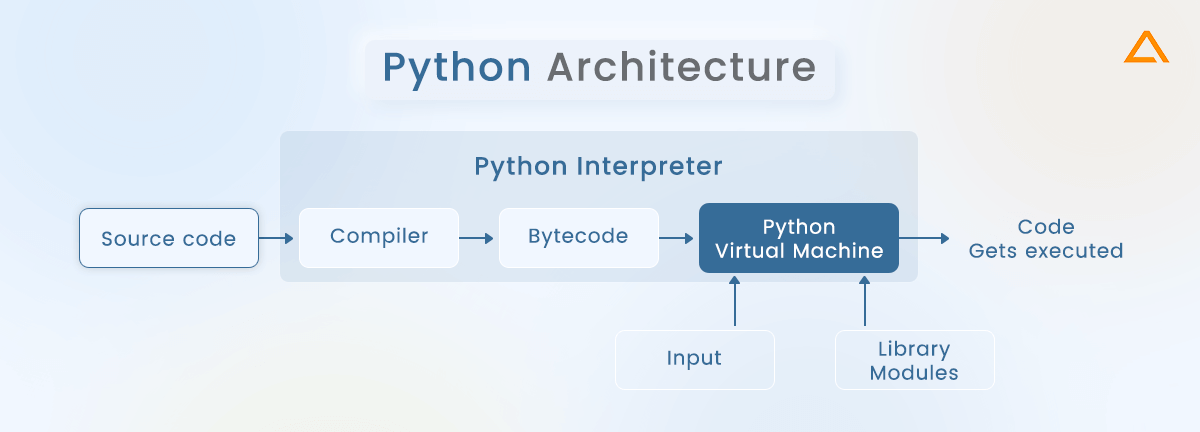
On the other hand, Java uses Java Virtual Machine that provides the runtime environment for executing the code and converting the bytecode into machine language.
Java Architecture

10. Python Interpreter vs Java Compiler
There are two types of translators – interpreters and compilers.
Python uses interpreters, whereas Java uses a compiler. An interpreter is an alternate option for implementing a programming language and more or less does the same work as a compiler. However, the interpreter processes the syntax tree directly for accessing expressions and executing the statement rather than generating code from the syntax tree. The problem with the interpreter is that it would require processing the same syntax tree more than just once, making it slower than executing a compiled program.
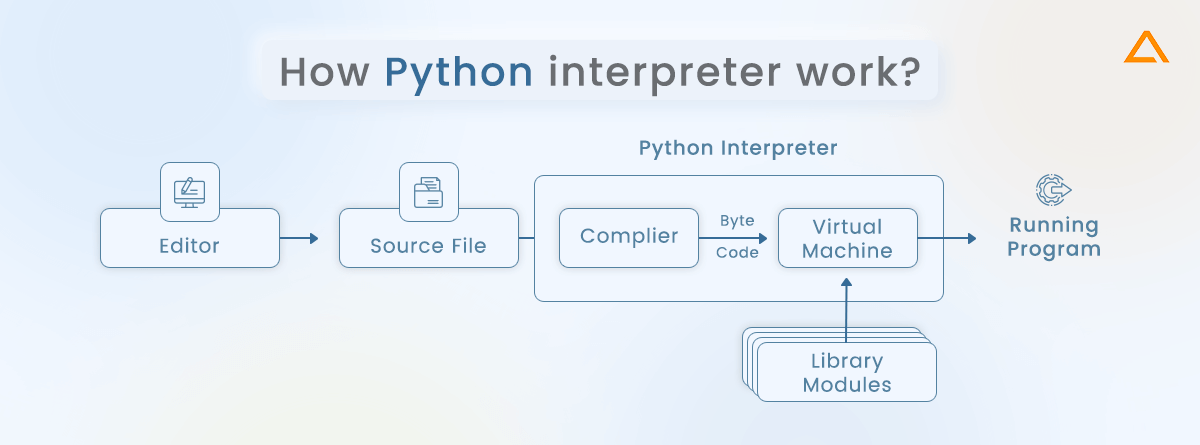
Opposed to this compiler reads a program written in a high-level language, turns it into the machine or simplified language, and reports the errors in the program. It can convert the entire source code in a shot or take multiple passes for doing the same. Either way, the user gets compiled code, which is ready to be executed. The returned target code file can use used with other inputs repeatedly.

Java’s compiler is faster than Python’s interpreter as the compiler can take the whole program at once, whereas interpreters compile every line of code one after the other.
11. Python vs Java Memory Management
Memory Management is the process of removing older unused objects to make space for new object allocations. This is important to manage working memory space and removing unreferenced objects. Some frameworks provide automatic memory management whereas others need some manual tweaking and setting. Let us see how Java compares to Python for memory management:
Java Memory Management
Java is a statically typed language that handles memory management automatically using the JVM. The Java Virtual Machine is responsible for allocation and deallocation of resources in Java applications. The JVM manages the heap, the garbage collector identifies and frees the objects that can’t be reached, for maintaining efficient memory usage. Java uses an explicit object lifecycle where objects are created explicitly using ‘new’ keyword and destroyed by setting their references to null. This helps ensure there’s lesser memory leaks, making memory management much easier.
Python Memory Management
Python follows an automatic memory management system as well; however, it is dynamically typed. Variables in Python don’t need to be declared and can possess different types of values based on requirements. Python relies on its Python Interpreter for managing heap and performing garbage collection. Unlike Java objects, Python objects follow the implicit lifestyle. As soon as any objects reference count drops to 0, they are automatically deallocated.
have a unique app Idea?
Hire Certified Developers To Build Robust Feature, Rich App And Websites
Wrapping Up!
The debate between Python’s dynamic approach and Java’s static approach is subjective to the user. Which programming language is better than the other is an endless argument. Hence, you should focus on understanding which programming language is better suited for your needs. Generally, Python is used for data.
